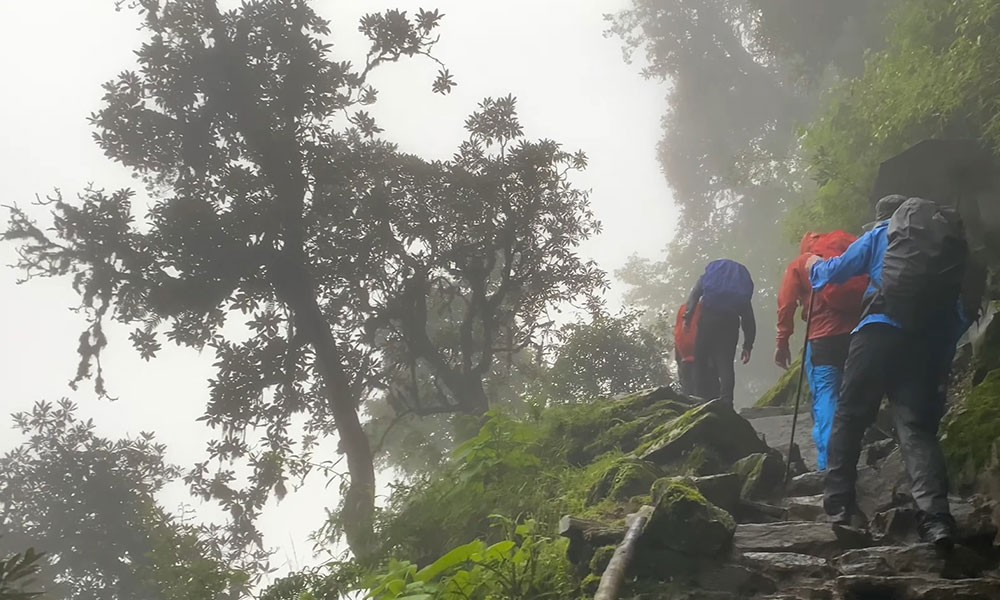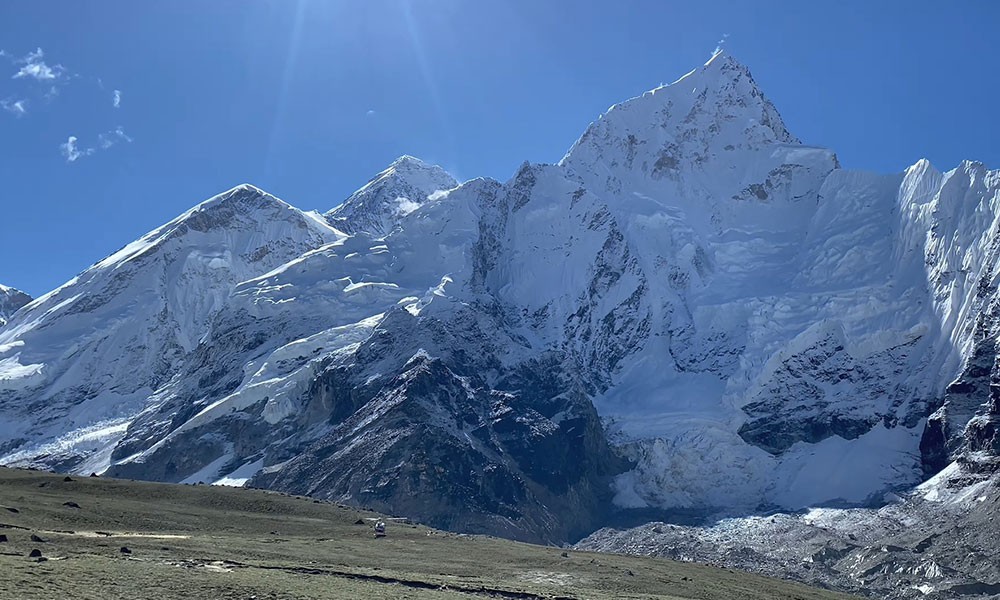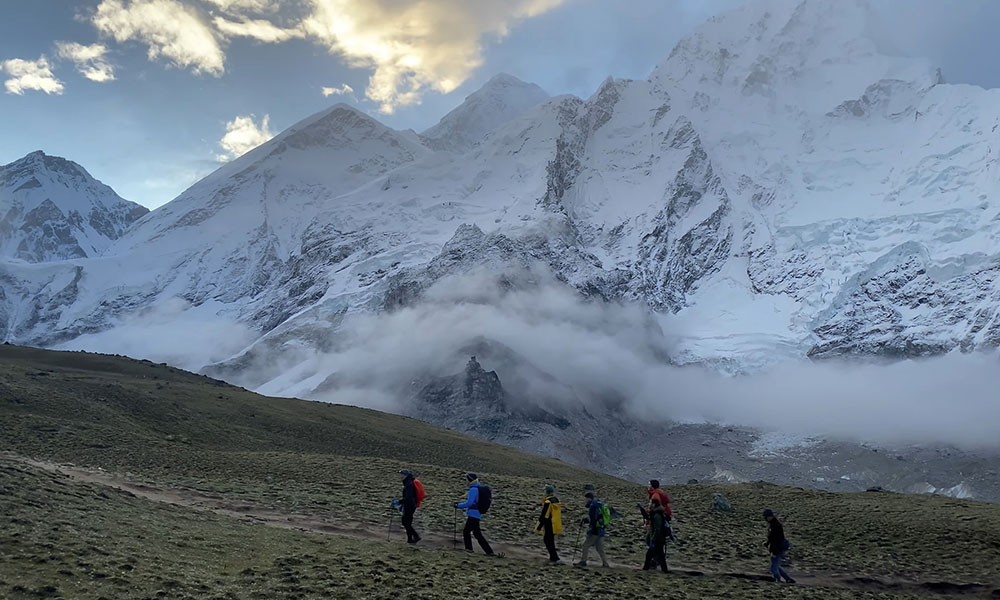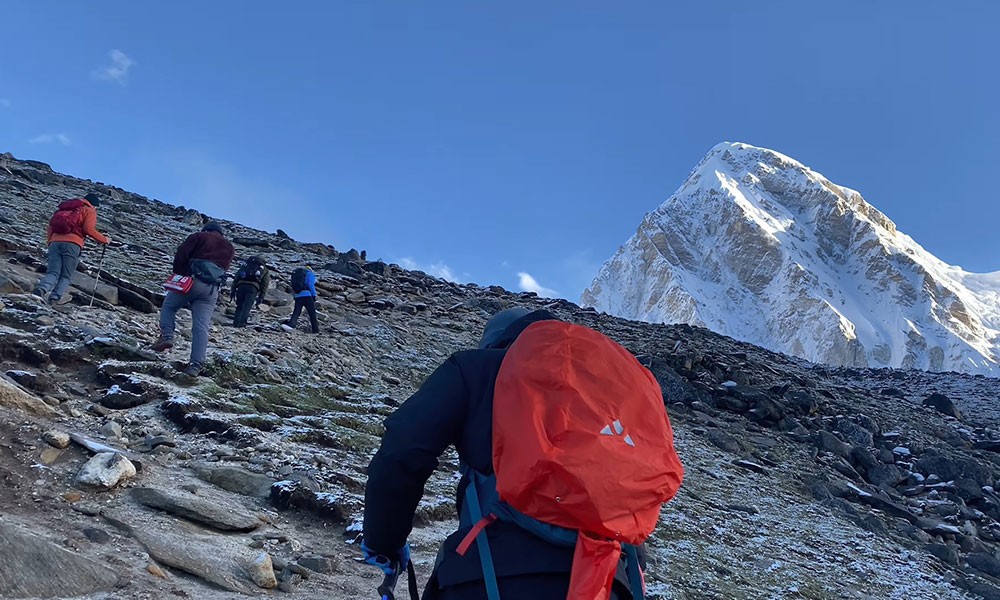
In Nepal, the summer monsoon season starts right in July. Besides, this month is considered the off-season for trekking in Nepal. However, with proper preparation, planning, and the support of a professional guide, the Everest Base Camp trek is also possible this month.
The best thing about the Everest Base Camp trek in July is that there is comparatively less crowd during this time. Suppose you are a peace lover and want to explore the beauty of the Nepali Himalayas in a peaceful nature. In that case, July is the best time for the Everest Base Camp trek.
Remember that you do not have to worry much because of rain in the monsoon season, as rainfall typically happens at night or evening, making the weather very clear during the day. Therefore, you can still experience the best view throughout the trial route.
Weather Conditions of Everest Base Camp in July
The weather condition of the Himalayan region in July is generally wet yet warm. Besides, monsoon season starts in mid-June and extends through July. There are chances of rainfall in the evening and the night. Still, the days are warm, letting you wander through the warmth at higher altitudes and the pleasant views of the surroundings.
Temperature can reach up to 17 degrees Celcius during the day. Still, it can reach around negative 4 to 5 degrees Celsius at night. Therefore, you need proper clothing and a warm sleeping bag rated for negative 4/5 degrees Celcius as it will help you sleep well at night.
Advantages of trekking in July
Even though trekking in July is not highly recommended. You can experience several advantages if you go for the EBC trek in July. In this section, we will be sharing some of the benefits that might encourage you to go for the trek this season:
Less Crowd
As mentioned above, there will be very few people in July. Trials will be relatively empty compared to other peak seasons, like spring and autumn so you can enjoy the trek in a peaceful environment. Furthermore, the teahouses and lodges will be significantly less crowded, making it comfortable for the trekkers to acclimate and rest.
Discounts in off-season
One of the best things you will get while trekking in July is the off-season discounts. These discounts start right from the flight rates, as airfares are cheaper in the off-season. Furthermore, the hotels and lodges also offer discounts on accommodations, but this might not be available in food. However, go in the off-season. You will have a chance to enjoy all the services provided by any lodges or accommodations, like, hot water showers. Additionally, due to the fewer people, you can easily find available rooms in lodges this month, and the staff can provide more individualized care.
Beautiful scenarios
This has also been mentioned in the overview section that because of the rainfall that happens in the nighttime, you can experience the best and the cleanest view from the Everest Base Camp trek route and Everest Base Camp in July. Remember that the environment will be more hygienic and greener in July, making the atmosphere pure. You will experience one of the best treks you will ever go on in the Himlayas. Furthermore, you can anticipate seeing a beautiful green forest with spring flowers, wild berries, and unbelievable biodiversity along the way.
Weather condition
One of the advantages of trekking the Everest Base Camp trek in July is the weather condition in this month. Even though the climate might fall to a negative scale in the night-time, it remains around 17 degrees Celsius during the day. Therefore, it would not be too cold, nor would it be too hot for you to trek. As a result, you can have a calm trek during the day and a cool rest at night.
Therefore, July is one of the best seasons for you to attempt the Everest Base Camp trek if you want a peaceful stroll with less crowd and also experience a budget-friendly trek. Clean surroundings and breathtaking views throughout the trek route will make your journey even more beautiful and worth remembering.
Furthermore, you could get a glimpse of several wild animals and lush forests. Therefore, imagine the views you will see from the Everest Base Camp and its surroundings and boost yourself to the Base Camp of the highest peak in the world.
Similar articles you may like: Everest Base Camp without a Guide | Everest base camp trek map | Everest Base Camp Trek Itinerary
Fooding and Accommodation During July
 As discussed in the section above, accommodation might be cheaper if you go to the Everest Base Camp in July. This is because Juky is considered off-season to go for this trek, making the place less crowded. As a result, fewer clients in the lodges and tea houses make the prices slightly lower. However, you should be okay with not getting facilities because of the low pricing of the lodges and teahouses, as they will still provide all the services to the trekkers.
As discussed in the section above, accommodation might be cheaper if you go to the Everest Base Camp in July. This is because Juky is considered off-season to go for this trek, making the place less crowded. As a result, fewer clients in the lodges and tea houses make the prices slightly lower. However, you should be okay with not getting facilities because of the low pricing of the lodges and teahouses, as they will still provide all the services to the trekkers.
Even though you might get discounts on accommodation facilities, you might not get those discounts on food. As July falls in the off-season, getting the raw food materials will be complex for the locals there, which might result in trekkers getting fewer or limited items on the menu and a higher price for the food.
However, the quality of the food will be better no matter which month or season it is. Therefore, you might get to eat a limited menu, but your taste buds will still overflow with joy. Furthermore, you will also need to provide your body with more proteins and other necessary ingredients to have the stamina and strength to trek in the off-season. Therefore, we suggest you refrain from compromising on fooding because they are expensive in July.
What to Pack?

As July is considered the off-season to go for the Everest Base Camp trek, the trials are more complicated than they will be in peak seasons. Therefore, trekkers must be careful while packing their backpacks for their journey. This section will help you know the best packing list you need if you attempt the Everest Base Camp in July.
- A big backpack in which you can carry sufficient warm clothes to help you avoid any type of snow-borne or altitude illness. Besides, the bag should be robust yet easy to carry at higher altitudes.
- As the sun's rays will be very high and scorching at a higher altitude, we recommend you carry sunscreens, sun caps, hats, and sunglasses to protect yourself from UV rays and the sun's scorching heat.
- Remember to carry as much liquid (water is highly recommended) to keep yourself hydrated throughout the trek. Also, take some energy bars and foods to give your body the necessary energy and protein.
- As July is a monsoon month, sometimes there are chances that the trial is muddy or slippery, so wear trekking boots with a firm grip to make walking the difficult trial easier.
- Even though you will be accompanied by professional guides who will carry the necessary first aid kits, it is recommended that the trekkers also take a first aid kit with them in case of any uncertain emergencies.
- Some essential gear to take on the Everest Base Camp trek are waterproof gear like raincoats, boots, trousers, etc., and some warm clothes with fleece and cozy and warm sleeping bags. These gears are essential as July is a monsoon month, so there are chances of rainfall, and the nights are relatively colder.
Importance of Guides in the EBC trek
.jpg)
No matter which treks you choose in Nepal, one of the essential things you need to know is that you can only get permits for the trek with a professional guide. Therefore, you need to hire an experienced guide who works for a registered trekking agency to go for the Everest Base Camp trek as well. Here we have listed some of the significant importance of hiring a guide:
Necessary Permits
To go for the EBC trek, a trekker should obtain two entrance permits: Sagarmatha National Park Entry Permit and Pasang Lhamu Rural Municipality Entrance Permit. The Sagarmatha National Park Entry Permit's fee is around NPR 3000 or $23. The Khumbu Pasang Lhamu Rural Municipality Entrance Permit will cost you NPR 2000 or above or $25 per person.
There is also one optional permit that you can obtain, which is the Gaurishankhar Conservation Area Permit. This permit is only necessary if you are traveling from the Jiri side, and it also costs around NPR 3000 or $23. Remember that you will need a professional guide to acquire these treks. You can only start the Everest Base Camp trek if you hire an experienced guide.
Navigation
A professional guide can help you navigate the Everest Base Camp trek in various ways. The main thing is that experienced guides know very highly about every trek path. They know about the terrain, weather conditions, altitude effects, and local culture and traditions. Therefore, they can enlighten the trekkers with the understanding that they have and make the trek more accessible and more efficient.
Besides, professional guides can also assist with necessary first aid and acclimatization. As they know the trek, they can make your journey comfortable and with security assurance. Also, remember that the guides can help you communicate with the locals throughout the trial because they will be fluent in local and foreign languages.
Searching for Accommodation
A professional guide will be handy for searching for the perfect Everest Base Camp trek accommodation. Remember that accommodation is one of the essential requirements for any circuit trek to gain proper energy and acclimatization throughout the Everest Base Camp trek.
Besides, a professional guide can also offer advice and recommendations based on their experience. You can also get to know the feedback about different hotels and lodges received from previous clients.
They can assist you in understanding what to expect from each lodging option and provide valuable information about the food quality, hygiene standards, and comfort level. Having a professional guide by your side will not only assist you in locating the ideal accommodation but also ensure that your overall trekking experience is pleasurable and trouble-free.
Tips for Trekking the Everest Base Camp in July
 As you read our blog about the Everest Base Camp trek in July, let us give you some professional tips to make your journey safer and more entertaining:
As you read our blog about the Everest Base Camp trek in July, let us give you some professional tips to make your journey safer and more entertaining:
Prepare yourself for Monsoon Season
You should be aware that July is part of Nepal's monsoon season. Therefore, there are chances of heavy rainfall and thunderstorm. Prepare for the rainy season and a slippery and muddy path. Carry appropriate gear, and we suggest you trek only in the daytime. We have already mentioned that the nighttime is mostly colder. The chances of rainfall are comparatively high.
Start the trek as early as possible
In July, evenings are primarily rainy, and night is icy. Therefore, as a professional trekking agency, we suggest you start the trek as early as possible to avoid the evening and night temperatures and showers.
Furthermore, suppose you start the trek earlier. In that case, you will reach the teahouse sooner, have more time for acclimatization, and keep yourself warm and cozy after a whole day of continuous walking.
Plan some leisure time
As you have to cover a high altitude, you might lose a lot of energy if you walk continuously without taking a break. Therefore, we recommend all trekkers separate for at least a few days for acclimatization or rest. On this day, you can stay in your teahouse or lodge and take a full day's rest, or you can also separate those days for sightseeing around the teahouses.
Furthermore, there might also be days when the weather could be better for ascending further. On those days, do not go out at any cost. Instead, stay back and enjoy the environment.
Follow your guides and their guidelines
One of the essential things you should do throughout the trek follows your guide right from the start. Stay on the route your guide suggests, and go on your own because you might need to learn how the upcoming portion of the trek might be.
If there are any emergencies or you need to take a break, tell your guide and do not continue the trek in that case.
Trips you may like:
Possible Itinerary of Everest Base Camp Trek in July
 This section provides you with the possible itinerary of Everest Base Camp by Marvel Adventures. However, you must remember that some changes might occur because of the weather condition in July.
This section provides you with the possible itinerary of Everest Base Camp by Marvel Adventures. However, you must remember that some changes might occur because of the weather condition in July.
Day 1: Fly from Kathmandu to Lukla (2,830 m.) and hike to Phakding (2,640 m., 4-hour trek).
Day 2: Trek from Phakding to Namche Bazaar. (3440m 6-7 hours)
Day 3: Acclimatization Day in Namche
Day 4: Trek to Tengboche (3,867 m., 5-6 hour trek) from Namche Bazaar.
Day 05: Trek to Dingboche (4,260 m., 5-6-hour trek) from Tengboche.
Day 06: Acclimatization Day
Day 07: Trek to Lobuche (4,930 m. 6 hour trek) from Dingboche.
Day 8: Trek from Lobuche to Gorak Shep (5,170 m), then to Everest Base Camp (5,364 m), then back (7-8 hour trek).
Day 9: Hike to Kalapathar (5,545 meters) and then trek to Pheriche (4,240 meters). 7-8-hour journey).
Day 10: 7-8-hour trek from Pheriche to Namche Bazaar
Day 11: Trek to Lukla (2,800 m., 7-8-hour trek) from Namche Bazaar
Day 12: Fly from Lukla to Kathmandu.
This is just the standard itinerary provided by Marvel Adventures. However, if you go for this trek in July, the days in the itinerary might increase because of the weather changes and climatic conditions.
Can a beginner go for the Everest Base Camp trek in July?
 Everest Base Camp is considered one of the most challenging treks in the Nepali Himalayas. On top of that, as July is a monsoon season, the difficulty level also increases to some extent.
Everest Base Camp is considered one of the most challenging treks in the Nepali Himalayas. On top of that, as July is a monsoon season, the difficulty level also increases to some extent.
Therefore, as a trekking agency, we do not recommend beginners to the Everest Base Camp, especially in July. If you want to trek, use easier circuit treks to warm up for the Everest Base Camp. Even if you are a professional trekker going for the EBC trek in July, remember to take all the necessary gear and requirements.
Ensure you are well-prepared physically and mentally before attempting the Everest Base Camp trek in July. You can start working out, running, skipping, and doing other exercises to increase your stamina and body strength. Besides, you must stay mentally stable by meditating and keeping your mind fresh throughout the trek to experience the best version of the Everest Base Camp trek in July.
Suppose you need to be more well-trained as a trekker. In that case, you might face a lot of difficulty in the Everest Base Camp trek because of the weather and many other factors. Therefore, we recommend only experienced trekkers for the Everest Base Camp trek in July.
Understanding the Threat of Altitude-related Illnesses
The Everest Base Camp trek is a base camp located 5,364 meters or 17,598 feet above sea level, so you will have to climb a lot. Therefore, you must ensure you do not indulge in altitude-related illnesses. This might make your tour quite tasteless, so make sure that you protect yourself from any altitude-related diseases that may catch you during the trek.
Understanding every aspect of the trek and its route before attempting the ascend will undoubtedly help you have a lifetime trekking experience. However, remember that a real trekker can face challenges and obstacles and reach the destination. Therefore, if you are an enthusiastic trekker, the Everest Base Camp might be the best for you in July or during monsoon season.
Therefore, you should carry a lot of warm clothes, trekking boots, gloves, and warm sleeping bags, and also remember to pack some waterproof jackets and trousers, as we have mentioned that July is a monsoon month. With proper research and awareness, you can accomplish the Everest Base Camp trek better and experience one of the most entertaining treks in the Himalayas of Nepal.
Final Words on Everest Base Camp trek in July
As you have gone through the complete article, let us give you a brief conclusion about attempting the Everest Base Camp in July. In conclusion, the Everest Base Camp trek in July is relatively easy and dangerous for experienced people. However, beginners are not recommended to attempt this trek in this specific month or during the monsoon season as they might feel some difficulties during the trek.
Finally, you want to go for the Everest Base Camp trek in July or any other month. In that case, you can contact us, Marvel Adventures. We and our professional guides are there to help you have a beautiful and memorable trek to the base of the tallest mountain in the world, Mt. Everest, in any season or month you want.
FAQ
Is July a good time to trek to Everest Base Camp?
Generally, July falls within the monsoon season, with perks and cons. You will see the best view, the least crowded trial and accommodation, and discounts. Still, on the other hand, you might also face challenges like rainfall, slippery and muddy trial, etc. Therefore, July would be best if you love challenges and want to experience a calm and peaceful trek to Everest Base Camp.
How to prepare for the EBC trek in July?
You must prepare your body and mind to trek to Everest Base Camp in July. Furthermore, packing necessary items like waterproof clothes, trekking boots, sunglasses, sunscreens, warm clothes, and proper sleeping bags are also some of the preparations needed before the trek.
Can I get proper accommodation facilities for the trial in July?
Yes, even though slightly fewer tea houses or lodges might be available this season, these places are less crowded. One of the best things about the accommodation at EBC in July is that many lodges and tea houses provide off-season discounts. Therefore, you can enjoy all the facilities at much lower prices.



 As discussed in the section above,
As discussed in the section above, 
.jpg)
 As you read our blog about the Everest Base Camp trek in July, let us give you some professional tips to make your journey safer and more entertaining:
As you read our blog about the Everest Base Camp trek in July, let us give you some professional tips to make your journey safer and more entertaining: This section provides you with the possible itinerary of Everest Base Camp by Marvel Adventures. However, you must remember that some changes might occur because of the weather condition in July.
This section provides you with the possible itinerary of Everest Base Camp by Marvel Adventures. However, you must remember that some changes might occur because of the weather condition in July. Everest Base Camp is considered one of the most challenging treks in the Nepali Himalayas. On top of that, as July is a monsoon season, the difficulty level also increases to some extent.
Everest Base Camp is considered one of the most challenging treks in the Nepali Himalayas. On top of that, as July is a monsoon season, the difficulty level also increases to some extent.

